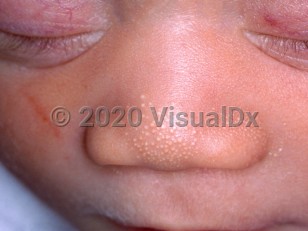Sebaceous hyperplasia in newborn
Alerts and Notices
Important News & Links
Synopsis

Sebaceous hyperplasia in newborns is a transient condition, influenced by androgens, and it represents localized hypertrophy of sebaceous glands on the face. It is most prominent around the nose and upper lip, where the density of sebaceous glands is highest. In the newborn, circulating maternal hormones can stimulate sebaceous gland growth and activity leading to sebaceous hyperplasia. Sebaceous hyperplasia owes its appearance to enlarged mature sebocytes and increased sebaceous gland acini.
Sebaceous hyperplasia occurs in nearly half of term newborns with premature infants being less commonly affected.
Sebaceous hyperplasia occurs in nearly half of term newborns with premature infants being less commonly affected.
Codes
ICD10CM:
L73.8 – Other specified follicular disorders
SNOMEDCT:
403852003 – Neonatal sebaceous gland hyperplasia
L73.8 – Other specified follicular disorders
SNOMEDCT:
403852003 – Neonatal sebaceous gland hyperplasia
Look For
Subscription Required
Diagnostic Pearls
Subscription Required
Differential Diagnosis & Pitfalls

To perform a comparison, select diagnoses from the classic differential
Subscription Required
Best Tests
Subscription Required
Management Pearls
Subscription Required
Therapy
Subscription Required
References
Subscription Required
Last Reviewed:08/30/2021
Last Updated:09/07/2021
Last Updated:09/07/2021

